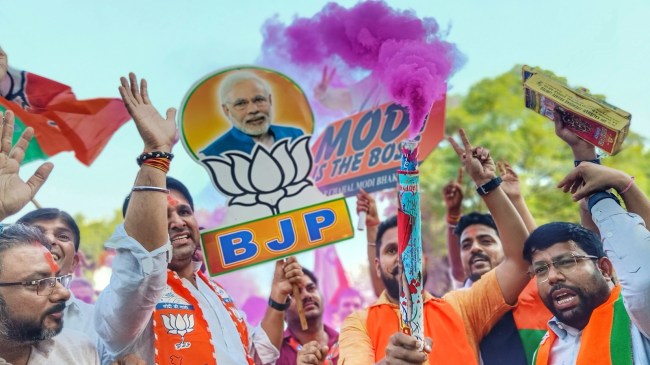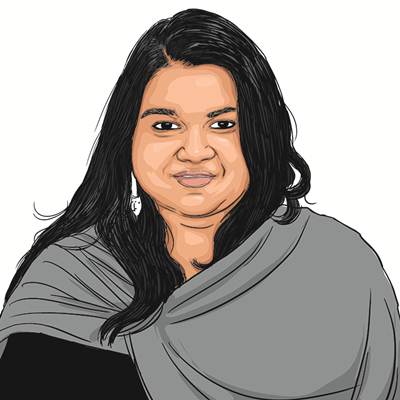Opinion How BJP consolidated the Dalit, OBC vote in Haryana — and why Congress could not
BJP’s victory in Haryana election shows that marginalised groups vote for the party which gives them their due
 Party supporters celebrate outside the BJP HQ after its victory in the Haryana Assembly polls, in New Delhi on Tuesday. (Express Photo by Tashi Tobgyal)
Party supporters celebrate outside the BJP HQ after its victory in the Haryana Assembly polls, in New Delhi on Tuesday. (Express Photo by Tashi Tobgyal) This year, the general election showed Dalit voters’ disenchantment with the BJP in Haryana, UP and the party’s other northern strongholds. However, the speed of turnaround on this front is evident from the results of the recently concluded assembly election in Haryana. This result has concretised the fact that currently there is only one big-tent party, The BJP. The past decade has metamorphosed the BJP from an upper-caste nationalist party to an all-encompassing political instrument that gives space to voices from all castes and beliefs. Be it Dalits, Pasmandas or other marginalised sections of society, leaders representing all interest groups have found their footing in the BJP. A tag, which, for several decades after Independence, was with Congress. However, unlike the Congress, the BJP has not played appeasement politics. Instead, it has spoken to the aspirations of marginalised groups. It has ensured that disenchanted communities find political leadership and mainstreamed their voices.
Voters are now able to discern the difference between what is being said and done. Whilst Congress was building up a narrative of Constitution and caste, the BJP was aligning itself with stark ground realities. It gave nine out of the 17 reserved tickets to Deprived Scheduled Castes (DSCs), a non-dominant and more deprived caste group amongst Dalits. Congress’s politics, in contrast, was being played by one particular family. It sidelined the Dalit leadership.
The Indian political system has, for decades, been able to transform societal stratification and communal divide into carefully crafted vote banks. After Babasaheb and Babu Jagjivan Ram ji, there was a significant gap in Dalit political leadership. The BJP, in the last decade, has been able to break into those silos to create a broad-based political spectrum of ideas and leaders. This was on display on Tuesday, when the results were being announced: Dalit communities, OBCs constitute a leadership caucus or bloc which decides whom to vote for as per its own preferences for party and candidate. It will not rely on the hollow rhetoric of the Constitution and caste when the actions of those espousing these values lean elsewhere.
This election outcome must also put a stop to the idea that voters’ memories are short-lived. They remember Congress’s time at the Centre and in state government – they promoted the dominant castes’ aspirations. This is evident from the front and centre role B S Hooda and his supporters played in the campaign, while Kumari Selja was missing from action. Jats canvassed for their leader Hooda, and quickly and quietly, the OBC and Dalit votes shifted to the BJP. The message is clear: Dalits and OBCs will vote not on symbolism but on action.
Haryana voters, more specifically Dalits and OBCs, have been clear in their pattern. They do not just want leaders to talk about caste and casteism, but what is being done on the ground. The Prime Minister’s focus on the pillars of garib (poor), yuva (youth), annadata (farmers), nari shakti (woman power) (GYAN) has found resonance among Dalit youth and women. From gas cylinders for Rs 500 to Haryana’s adoption of Madhya Pradesh’s Ladli Behna Yojana in the form of Lado Lakshmi Yojana struck a chord with women from Dalit and OBC backgrounds. Apart from this, several women and youth-centric schemes by the central government have benefited not only Hindu Dalits and OBCs but Muslim women and youth, too.
Despite their differences, all sections of the media have noted one thing: Government schemes, whether central or state, whether BJP-ruled or not, have reached the last intended person on the ground. The churning of the majority of socio-political structures and re-alignment of voters from marginalised classes and castes has made the BJP’s Fourth Party System more resilient. It is now set to play a central role in India’s polity, where voters are not just concerned about local issues but also about the overall growth trajectory of the country. Dalits are not just a part of the electorate. They want to play a major role in electoral politics. They will support the party they think will give respectable space to their leaders, ideas and aspirations.
The writer is assistant professor of Sociology, Lakshmibai College, Delhi University




